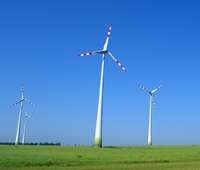Argonne gets wind of new energy models

(PhysOrg.com) -- Sailors and golfers aren't the only people interested in knowing how much the wind blows; people who run wind farms need to know too.
Researchers at the U.S. Department of Energy's Argonne National Laboratory, with support from the Institute for Systems and Computer Engineering of Porto (INESC Porto), are developing new wind power forecasting techniques that they hope will allow power system operators and wind power plant managers to more accurately predict the amount of electricity that the wind power plants will generate at any given time.
Unlike coal or nuclear power plants, wind farms produce energy in fits and spurts. When the wind is not blowing and a wind farm fails to produce much power, other power plants must increase their generation to pick up the slack. Argonne scientists seek to use wind power forecasts to help power plant operators run their plants more efficiently.
"The point of this project is to reduce uncertainty," said Audun Botterud, an energy systems engineer with Argonne's Center for Energy, Environmental, and Economic Systems Analysis. "The more accurately we can predict how much wind there will be, the more efficiently and cheaply we can generate and transmit all of our power."
Current wind power forecasting models use inputs from a range of sources, including weather predictions, meteorological measurements and current output levels of wind power farms, to generate the best possible forecast for times ranging from minutes to days ahead. "Our models merge the information from all these sources to generate the best possible forecast," says Botterud.
However, the definition of "best," Botterud said, depends on one's point of view. According to Botterud, wind power generators primarily care about minimizing the average error in the quantity of wind available. In contrast, system operators seek to accurately forecast rapid changes in electrical output.
"The next-day forecast is particularly important," Botterud explained. "The power generation and distribution companies make supply and demand bids in the power market today for their anticipated needs tomorrow, but the market usually closes by early afternoon. If not enough wind power is generated, the operator may not have sufficient other resources to meet the system's load. On the other hand, if there is more wind than expected, the operator may have to force wind generators to reduce their output to avoid problems in the rest of the power system."
With a more accurate wind power forecast, power system operators can better anticipate how much energy they will need from other plants on the same grid. "Large-scale mathematical models are used to efficiently schedule electrical generation," said Jianhui Wang, another energy systems engineer working on the project. "We are looking at how to account for wind power uncertainty in these models, and that adds additional complexity from a mathematical perspective."
"Although wind farms currently supply only a small percentage of America's electricity, improving our forecasting capabilities and these operational models represent a hugely important part of what's required to maintain the reliability and stability of the entire system. This improvement will yield large rewards as the country's wind-power generation capacity is scaled up," Wang added.
More information: More information on the project is available at the DIS website.
Provided by Argonne National Laboratory
















